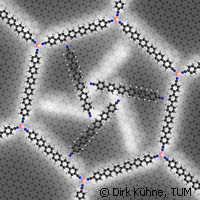EU scientists discover self-organising nano structures with loads of potential
An EU-funded research team from Germany has captured rod-shaped molecules in a two-dimensional (2D) network, effectively creating small rotors that turn in cages shaped like honeycombs. Their discovery is an outcome of the MOLART ('Surface-confined metallosupramolecular architecture: towards a novel coordination chemistry for the design of functional nanosystems') project, which clinched a European Research Council (ERC) Advanced Grant worth EUR 2.57 million under the EU's Seventh Framework Programme (FP7). The research is presented in the journal Proceedings of the National Academy of Sciences (PNAS). The researchers, led by Professor Johannes Barth at the Technische Universität München (TUM), Germany, explained that proteins help bring reactants together. 'The confinement of molecular species in nanoscale environments leads to intriguing dynamic phenomena,' the authors write in their paper. Surface reactants 'meet' on the surface of the facilitators, according to the researchers. While it is still too early to get nano machines to assemble themselves via self-organisation effects, the work performed by the TUM team is a step in the right direction. Initially, the scientists created a nano lattice by enabling cobalt atoms and rod-shaped molecules of sexiphenyl-dicarbonitrile to react with each other on a metal surface. What emerged is a honeycomb-shaped lattice that is not only consistent but stable. The lattice is just one atom thick. Their discovery brings to mind another breakthrough recently made by EU-funded researchers, who won a Nobel Prize for their work on 2D grapheme. 'Notably, the organisation and rotational motions of individual molecules were controlled by carefully designed, fully supramolecular host architectures.' The team used an open 2D coordination network on a smooth metal surface to guide the self-assembly of non-convalently bound dynamers (trimeric guest units). 'Each caged chiral supramolecule performs concerted, chirality-preserving rotary motions within the template honeycomb pore, which are visualised and quantitatively analysed using temperature-controlled scanning tunnelling microscopy,' they point out. Rods spontaneously came together, in groups of three, in a honeycomb cell while adjacent cells remained empty when the researchers added molecular building blocks, they said. But why did the molecules organise themselves in threesomes? The TUM scientists discovered that the molecules oriented themselves in groups of three, where the nitrogen ends each faced a phenyl-ring hydrogen atom. According to the team, 'this triple-bladed rotor arrangement' allows the molecules to sustain the structure regardless of the energy used to steer the rotation. Because of the interactions between the outer nitrogen atoms and the hydrogen atoms of the cell wall, two varied positions exist. The three molecules also position themselves in a clockwise and a counter-clockwise manner. Using controlled temperatures, the researchers 'froze' and assessed the four states thoroughly. Doing so helped them identify the energy of these thresholds from the temperature at which the rotation resumed, they said. 'We hope that in future we will be able to extend these simple mechanical models to optical or electronic switching,' explains Professor Barth. 'We can set a specific cell size, we can specifically bring in further molecules and study their interaction with the surface and the cell wall. These self-organising structures hold enormous potential.' Researchers from the University of Strasbourg in France contributed to this study.
Countries
Germany, France



